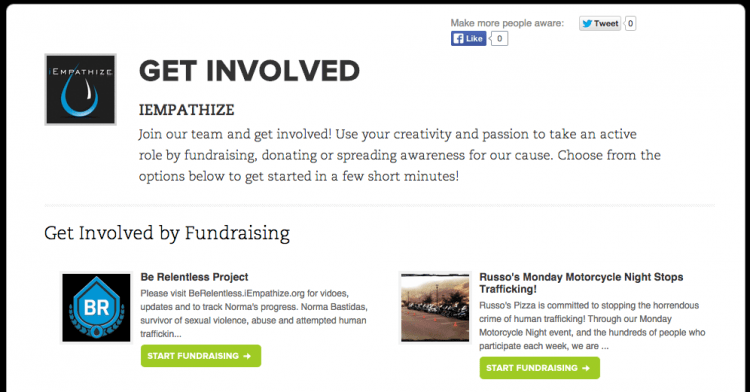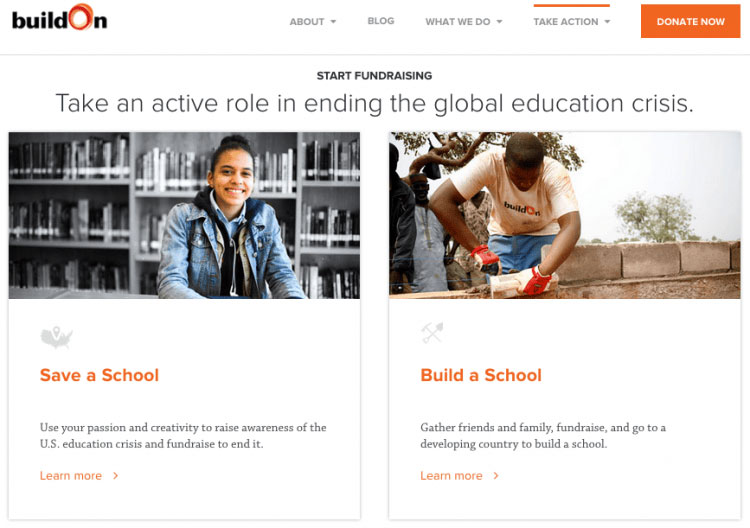What Is Peer-to-Peer Fundraising?

Request a Demo
Learn how top nonprofits use Classy to power their fundraising.
In the nonprofit world, peer-to-peer fundraising, a specific form of crowdfunding campaigns, has become increasingly prevalent. The terms are often thrown around interchangeably, although they’re two different approaches to raising money.
What Is Peer-to-Peer Fundraising?
You’ve probably heard about crowdfunding. Well, peer-to-peer fundraising is a specific type of crowdfunding.
Peer-to-peer fundraising is a multi-tiered approach to crowdfunding. This means individuals can create personal fundraising pages for your cause’s behalf. This can feed revenue back to your organization as a whole, or to a specific campaign you’re running. Either way, the individual shares his or her page with friends, family, and community members for donations (hence “peer-to-peer”).
Now, let’s dive into the specific elements that make peer-to-peer fundraising unique.
Set Up a Stellar Campaign
Peer-to-peer fundraising is “multi-tier,” so an organization can empower its donors to create personal fundraising pages and raise money on its behalf. This ability to draw on your network’s network can increase donations and allow you to reach new pools of donors that might have been inaccessible otherwise.
Expand Your Reach With Access to New Networks
Rather than banking on instant mass appeal, peer-to-peer fundraising campaigns build momentum by engaging and activating fundraisers, who then reach out to their own networks for support. That being said, you can increase your overall chances of success by first appealing to a core group of supporters and evangelists who can start fundraising, create initial momentum, and build social proof for your campaign or cause.
Fundraisers have high personal buy-in: One of the main components of peer-to-peer is its ability to give fundraisers an opportunity to individualize the cause and explain why it matters to them. Supporters can connect their own beliefs, values, and identity to your mission, and their personal fundraising pages become a vehicle for them to express their stories in their own words.
As a result, supporters are more self-assured in their involvement and are willing to share their message, as it relates to yours, with other people. This individual investment in your cause can lead to high fundraising goals and a personal desire to see your campaign succeed.
Peer-to-peer campaigns also increase trust between your organization and new potential supporters, as they learn about your cause through a friend’s page. People are more likely to donate to a cause their friend or family feels strongly about, so allowing others to fundraise for you can be an amazing way to grow your supporter base.
Provide Fundraisers With the Tools They Need to Succeed
Although your fundraisers are doing the asking, this doesn’t mean you can sit back and expect donations to roll in.
Peer-to-peer presents a unique opportunity to have your supporter base help rally their networks around your cause. Your individual supporters ask their friends and family to donate to their personal fundraising page, allowing you to leverage the preexisting trust between the asker and asked to increase the credibility of your appeal.
However, this also means your success relies directly on your fundraisers’ results. You must provide the tools and education your fundraisers need for their personal success.
Create resources that make them feel confident to share and represent your mission. Some content ideas include:
- A fundraiser’s toolkit
- Email templates and sample social media posts
- Design resources for personal fundraising pages
- Videos of your fieldwork
- Premade graphics for social media banners (at least, Facebook and Twitter)
With peer-to-peer fundraising, you’ll want to reach out to your fundraisers, proactively offer resources and instruction, and help them develop an individualized strategy for success.
Get Creative With Your Campaigns Types
There are two main types of peer-to-peer campaigns: “rolling campaigns” and “time-based campaigns.”
Rolling, or year-round campaigns, revolve around your supporters’ life events. Whether it’s a birthday, holiday, wedding, or athletic endeavor, (or just because!) supporters can use any occasion as an opportunity to fundraise for your organization.
By implementing this option as a permanent fixture on your website, you enable your fundraising community to take action on behalf of your organization outside of your hosted campaigns or events.


Time-based campaigns, on the other hand, take place within a specific timeframe, generally 6-8 weeks. They’re usually fixed around a specific theme or activity, such as a holiday campaign or one that supports a certain program. Because you have a limited timeframe to reach a specific fundraising goal, this campaign type requires a proactive marketing strategy to spread the word and rally support around your campaign.
Test Out Team Fundraising
To get supporters even more excited about a campaign, you can encourage them to fundraise as a team. Each team member makes their personal page, but the results are also logged on a team page. This is a great idea for a nonprofit 5k run or holiday fundraiser. Encouraging a little competitive edge can help individual fundraisers conquer their fears about asking for donations.
Host Offline Events to Raise More for Your Cause
Combined registration and fundraising: Implement peer-to-peer fundraising in your event, like a race or gala fundraiser, by setting up combined registration and fundraising. In addition to (or instead of) a registration fee, ask participants to create a fundraising page and raise a certain amount to gain entrance into the event. They can drum up support or get other people excited about attending by fundraising in the weeks before your event.
Build Brand Recognition
You work hard to establish your nonprofit brand. Brand recognition helps supporters establish and maintain trust in your organization. By leveraging the right peer-to-peer fundraising platform, you can (and should) maintain and uphold your organization’s branding across your campaign and fundraising pages.
It’s Time to Try Peer-to-Peer for Yourself
1. Peer-to-peer fundraising is another form of crowdfunding
2. Peer-to-peer fundraising enables you to raise more money from more supporters because it relies on individuals’ networks
3. Peer-to-peer fundraising allows supporters to own your cause and raise money for you in place of a life event, like a birthday or graduation
4. Peer-to-peer fundraising can strengthen your supporter community by increasing donors’ personal buy-in and incorporating team fundraising efforts for your cause
As you can tell, the options to get creative with peer-to-peer campaigns are nearly endless. Whether you decide to allow supporters to fundraise for your cause year-round, or to amplify your efforts around a specific campaign, peer-to-peer fundraising can really elevate engagement and revenue for your cause.

Get Your Peer-to-Peer Campaign Checklist
Subscribe to the Classy Blog
Get the latest fundraising tips, trends, and ideas in your inbox.
Thank you for subscribing
You signed up for emails from Classy
Request a Demo
Learn how top nonprofits use Classy to power their fundraising.


